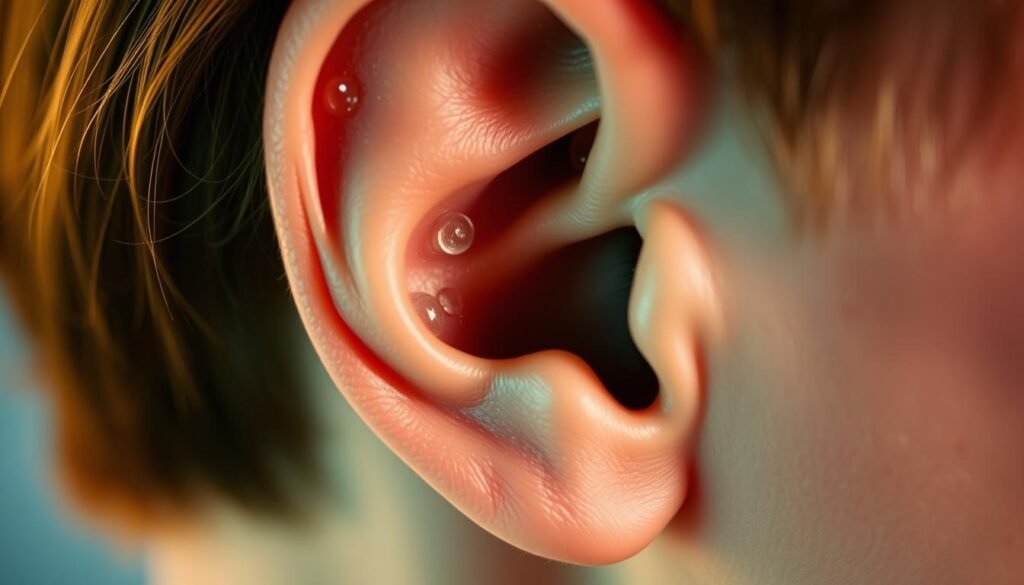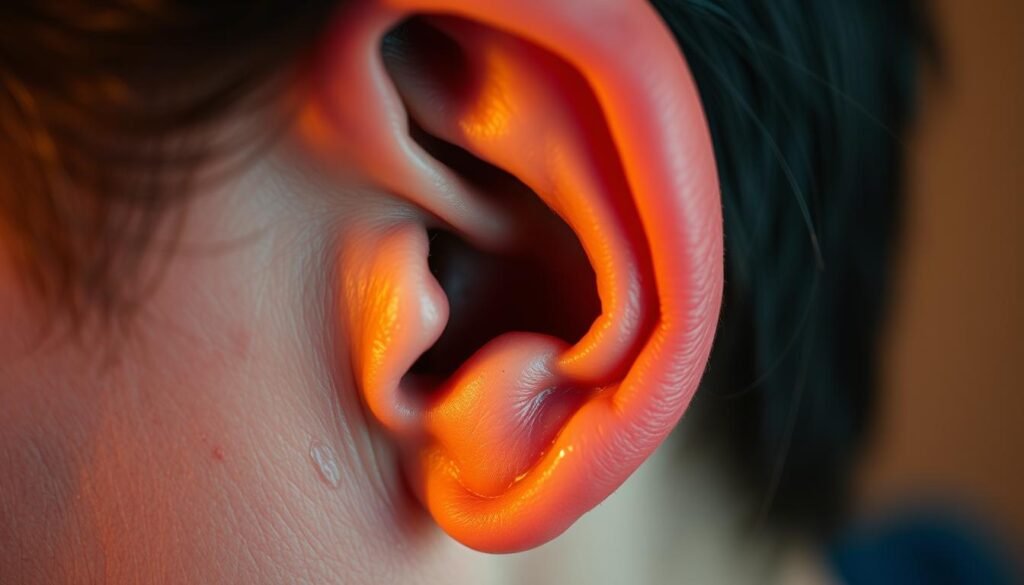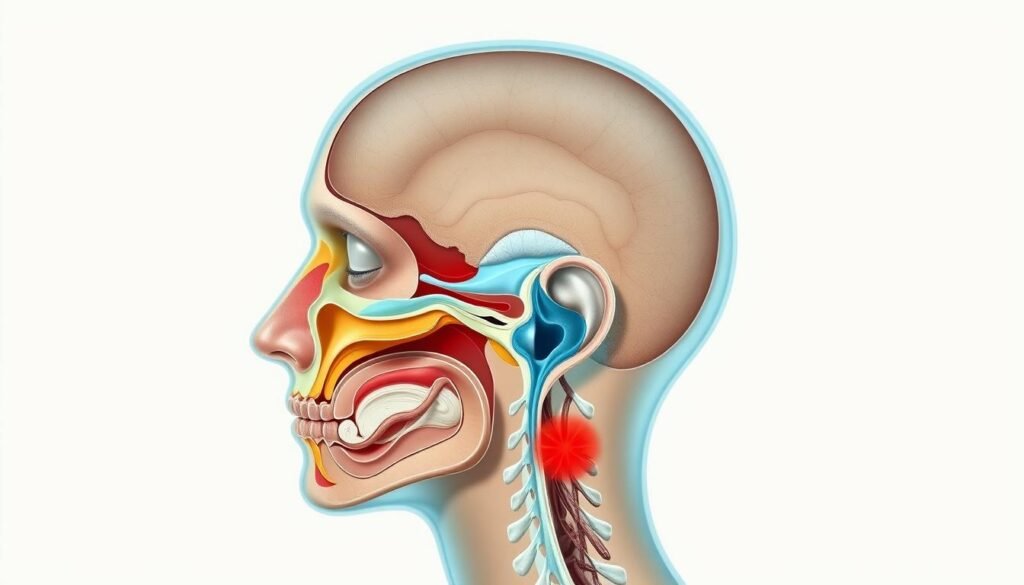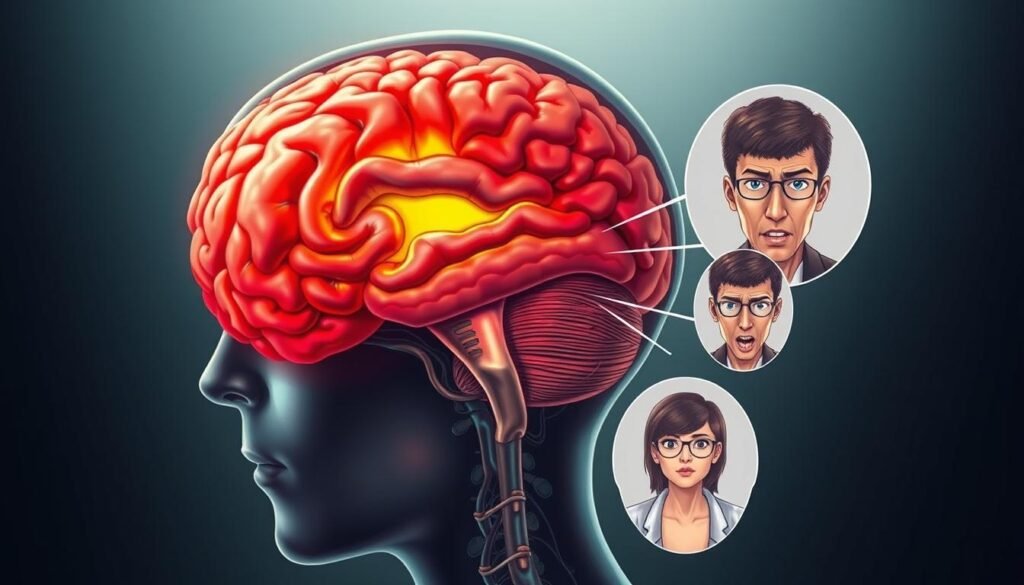Experiencing a pounding headache combined with ear pain can be debilitating, affecting your daily life and overall health. The discomfort can range from mild to severe, making it challenging to concentrate on even the simplest tasks.
This comprehensive guide will help you understand the link between these symptoms, exploring the various conditions that can cause this uncomfortable combination. For more information on different types of headaches, you can refer to our detailed guide on understanding various headache types.
By understanding the underlying causes of your discomfort, you’ll be better equipped to find effective relief and treatment options.
Key Takeaways
- Understanding the connection between pounding headache and ear pain
- Identifying the various conditions that cause these symptoms
- Learning about different types of headaches that can accompany ear pain
- Discovering effective relief and treatment options
- Knowing when to seek medical attention for these symptoms
Understanding the Connection Between Headaches and Ear Pain
Understanding the link between headaches and ear pain requires a comprehensive look at the nervous system and its role in pain perception. The connection between these two types of pain is complex, involving various physiological and neurological factors.
How the Nervous System Links Head and Ear Pain
The nervous system plays a crucial role in transmitting pain signals. Migraine, an inherited problem of ion channels in the brain, can result in a “sensitive brain” that intensifies reactions to stimuli. This sensitivity can lead to both headaches and ear pain, as the brain struggles to adapt to environmental stimuli.
Common Patterns of Combined Symptoms
When headaches and ear pain occur together, they often follow recognizable patterns. These patterns can help identify the underlying cause. Common symptoms include throbbing or pounding headaches that intensify with movement, accompanied by sharp or dull pain in one or both ears.
| Symptom Pattern | Description | Possible Cause |
|---|---|---|
| Throbbing headache and ear pain | Pain intensifies with movement | Migraine or sinus issue |
| Pressure sensations in head and ears | Feelings of fullness or congestion | Sinus pressure or Eustachian tube dysfunction |
| Sensitivity to light and sound | Increased sensitivity during episodes | Migraine or neurological sensitivity |
Pounding Headache and Ear Pain: Common Causes

Experiencing a pounding headache accompanied by ear pain can be debilitating, and understanding the underlying causes is crucial for effective relief. The connection between these two symptoms can be attributed to various factors, including migraines, sinus infections, and ear conditions.
Migraine and Its Atypical Presentations
Migraines are a common cause of pounding headaches and can sometimes be accompanied by ear pain. Atypical presentations of migraines may include symptoms such as ear fullness or pain, making diagnosis challenging. Understanding the link between migraines and ear pain is essential for appropriate treatment.
Sinus Infections and Pressure
Sinus headaches involve pressure or pain in the forehead, brow, below or behind the eye, and sometimes behind the ear. The pain is typically constant and can be on one side or both sides of the head. Blowing the nose, moving quickly, lying down, and bending forward often intensify the pain. Sinus infections can lead to ear pain due to the Eustachian tube’s connection between the middle ear and the back of the nose.
Ear Conditions That Cause Referred Pain
Several ear conditions can cause pain that radiates to the head, creating the sensation of a headache. These include otitis media (middle ear infection), otitis externa (swimmer’s ear), Eustachian tube dysfunction, mastoiditis, temporomandibular joint (TMJ) disorders, and cholesteatoma. Treating the underlying ear condition is crucial for alleviating both ear pain and associated headache.
| Ear Condition | Description | Symptoms |
|---|---|---|
| Otitis Media | Middle ear infection | Ear pain, fullness, pressure, throbbing |
| Otitis Externa | Infection of the ear canal | Sharp ear pain, worsens with touch or movement |
| Eustachian Tube Dysfunction | Impaired pressure regulation | Ear fullness, pain, referred headache pain |
Migraine-Related Ear Symptoms

Migraine-related ear symptoms can be quite debilitating, affecting not just the head but also the balance and overall well-being of an individual. These symptoms often manifest as dizziness, vertigo, and other balance-related issues, significantly impacting the quality of life for those affected.
How Migraine Affects the Inner Ear
Migraine can significantly affect the inner ear, leading to various symptoms including dizziness and vertigo. The inner ear is responsible for balance and equilibrium, and when migraine affects this area, it can cause episodes of vertigo, making it challenging for individuals to maintain their balance.
Approximately 25% of people who experience migraines also suffer from vertigo, highlighting the significant overlap between migraine and balance disorders.
Vestibular Migraine and Balance Issues
Vestibular migraine is a specific type of migraine that primarily affects the balance system in the inner ear. This condition causes episodes of vertigo, dizziness, and imbalance that can be more debilitating than the headache itself. Many patients with vestibular migraine report a feeling of “rocking” or “swaying,” as if they’re on a boat, even when standing still.
The balance issues associated with vestibular migraine may occur before, during, after, or even completely separate from headache episodes, making diagnosis challenging. Treatment typically involves both acute management of vertigo episodes and preventive strategies to reduce the frequency and severity of attacks.
Sinus-Related Headaches and Ear Discomfort

The connection between sinus problems and ear pain is more than coincidental, as the two are intricately linked through the body’s anatomy. Sinus issues can directly impact ear function due to their close proximity and shared drainage pathways.
Recognizing Sinus Pressure Symptoms
Sinus pressure symptoms can be quite distinct, often involving pain and pressure around the eyes, cheeks, and forehead. People with chronic or severe allergies are particularly at risk during certain seasons or when exposed to specific allergens like pets. Recognizing these symptoms early can help in seeking appropriate treatment.
How Sinus Problems Affect the Ears
Sinus problems can significantly affect the ears due to the connection through the Eustachian tubes. When sinus inflammation blocks these tubes, it can lead to ear pain, pressure, and muffled hearing. The blockage creates negative pressure in the middle ear, causing the eardrum to retract inward. Furthermore, fluid from inflamed sinuses can back up into the Eustachian tubes and middle ear, potentially leading to secondary ear infections.
| Symptom | Cause | Effect |
|---|---|---|
| Ear Pain | Sinus Inflammation Blocking Eustachian Tubes | Negative Pressure in Middle Ear |
| Muffled Hearing | Fluid Backup into Middle Ear | Impaired Sound Conduction |
| Popping or Crackling Sensation | Eustachian Tube Dysfunction | Discomfort During Swallowing orYawning |
Treating the underlying sinus condition is crucial for resolving associated ear symptoms. Addressing only the ear symptoms will provide temporary relief at best.
Serious Conditions That Cause Head and Ear Pain

While most cases of head and ear pain are related to common conditions, there are instances where these symptoms can be indicative of more serious underlying health issues. It’s essential to be aware of these potential serious conditions to seek medical attention when necessary.
Meningitis Warning Signs
Meningitis, an infection that inflames the protective membranes covering the brain and spinal cord, can cause severe headache and ear pain. Other warning signs include fever, stiff neck, sensitivity to light, and confusion. If these symptoms are present, immediate medical attention is crucial as meningitis can be life-threatening.
Brain Aneurysms and Pressure Symptoms
A brain aneurysm is a bulge or ballooning in a blood vessel in the brain. When it ruptures, it can cause a sudden, severe headache, often described as “the worst headache of my life.” Other symptoms may include nausea, vomiting, and sensitivity to light. The increased pressure can also lead to ear pain and other neurological deficits.
When Tumors Cause Head and Ear Pain
Changes in hearing and pain in the ear can be associated with tumors, particularly those affecting the auditory nerve. Tumors in or near the brain can increase pressure inside the skull, leading to headache and ear pain. Other potential symptoms include dizziness, balance issues, and facial numbness. Early diagnosis is critical for effective treatment.
Diagnosing the Source of Your Symptoms
Accurately identifying the cause of your headache and ear pain is the first step towards finding a suitable treatment. To achieve this, it’s essential to track your symptoms and potential triggers.
Tracking Symptoms and Triggers
Keeping a simple diary can be a valuable tool for you and your doctor. Use a monthly calendar to mark the days you experience headaches and ear pain, as well as any other related symptoms. Note any possible triggers that may have occurred in the 24 hours prior to your symptoms.
What to Tell Your Doctor
When consulting your doctor about your headaches and ear pain, provide a detailed description of your symptoms. Be specific about the timeline, location, and character of your pain. Share information about any known triggers, your medical history, and how your condition affects your daily life. This information will help your doctor understand the severity of your condition and develop an appropriate treatment plan.
Treatment Options for Headache and Ear Pain Relief
Treatment for headache and ear pain can vary significantly depending on the underlying cause. Understanding the diverse treatment options available is crucial for effective management.
Medication Approaches
Medications play a crucial role in managing headache and ear pain. Over-the-counter pain relievers such as ibuprofen or acetaminophen are often the first line of treatment. In some cases, prescription medications may be necessary, especially if the pain is severe or related to a specific condition like migraine.
Home Remedies and Lifestyle Changes
In addition to medication, several home remedies and lifestyle changes can help alleviate headache and ear pain. Staying hydrated, managing stress through relaxation techniques, and avoiding triggers can reduce the frequency and severity of symptoms. Applying a warm or cold compress to the affected area may also provide relief.
Medical Procedures for Severe Cases
For severe or persistent cases that do not respond to standard treatments, various medical procedures may be necessary. These can include nerve blocks, Botox injections for chronic migraine prevention, and surgical procedures for conditions like chronic sinus problems or Eustachian tube dysfunction.
| Procedure | Description | Condition Treated |
|---|---|---|
| Nerve Blocks | Injecting anesthetic around specific nerves | Severe headache and ear pain |
| Botox Injections | Botulinum toxin injections every three months | Chronic migraine prevention |
| Endoscopic Sinus Surgery | Surgical procedure to address sinus issues | Chronic sinus problems |
| Myringotomy | Ear tube placement | Eustachian tube dysfunction |
It’s essential to consult with a healthcare professional to determine the best course of treatment. They can help identify the underlying cause and recommend appropriate medications or care tailored to the individual’s needs.
Conclusion: When to Seek Medical Attention
It’s essential to recognize the warning signs that indicate the need for immediate medical care for headache and ear pain. Certain conditions, such as a stiff neck with fever, severe headache, or neurological symptoms, require urgent evaluation.
If you experience sudden hearing loss, severe vertigo, or significant changes in ear symptoms, seek medical help. People with a history of certain medical conditions should be more cautious. Early diagnosis and treatment can lead to better outcomes.

